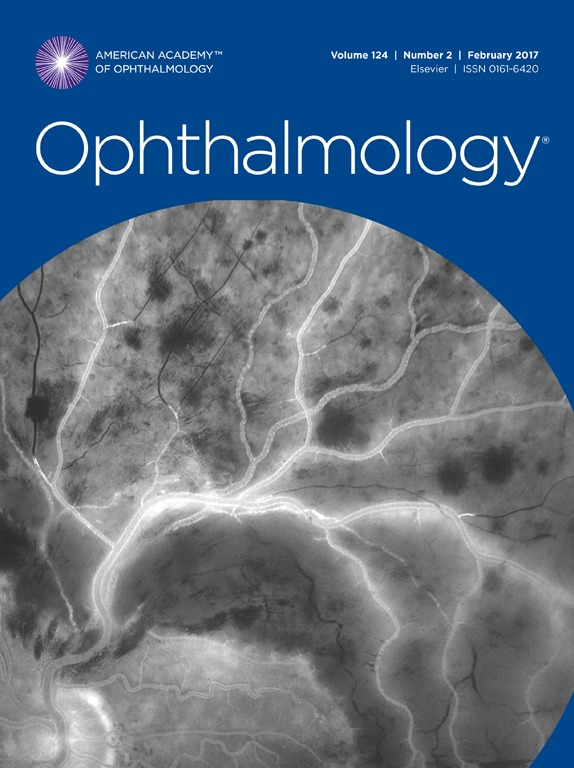Reversal of Pharmacologically Induced Mydriasis with Phentolamine Ophthalmic Solution
IF 13.1
1区 医学
Q1 OPHTHALMOLOGY
引用次数: 0
Abstract
Purpose
To evaluate the safety and efficacy of 0.75% phentolamine ophthalmic solution (POS), an α-adrenergic antagonist, in reversal of pharmacologically induced mydriasis.
Design
Two phase 3, multicenter, placebo-controlled, randomized, double-masked clinical trials in healthy participants.
Participants
Five hundred fifty-three healthy 12- to 80-year-old participants were randomized 1:1 (MIRA 2) and 2:1 (MIRA 3) to receive either POS or placebo eye drops in both eyes.
Methods
Participants received POS or placebo administered 1 hour after mydriasis, induced by instillation of either 2.5% phenylephrine, 1% tropicamide, or 1% hydroxyamphetamine / 0.25% tropicamide.
Main Outcome Measures
Percent of participants returning to within 0.2 mm of baseline pupil diameter in study eye 90 minutes after POS administration. Safety measures included treatment-emergent adverse events and tolerability measures, including conjunctival hyperemia.
Results
A total of 553 participants were randomized to treatment with placebo (n = 215) or POS (n = 338). A statistically significant greater percentage of participants treated with POS showed reversal of mydriasis at 90 minutes compared to placebo (MIRA 2: 48.9% vs. 6.6% [P < 0.0001]; MIRA 3: 58% vs. 6% [P < 0.0001]) and as early as 60 minutes (MIRA 2: 27.7% vs. 2.2% [P < 0.0001]; MIRA 3: 42% vs. 2% [P < 0.0001]). Between 28% and 34% of participants receiving placebo did not returned to baseline PD at 24 hours after pharmacologic dilation compared with 8% to 11% of patients treated with POS (P < 0.0001).
Conclusions
Treatment with POS reduced PD within 60 to 90 minutes, with a statistically significant time savings of 5 to 6 hours to return to baseline PD compared with placebo. One or 2 drops of POS rapidly reversed mydriasis in all participants regardless of mydriatic agent or iris color. More participants receiving POS reported a benefit in the resolution of visual symptoms caused by pharmacologically induced mydriasis compared with placebo, with statistically significant differences noted as early as 1 hour. The safety profile was favorable, with the most common adverse effects being mild transient conjunctival hyperemia (11.2%), instillation site discomfort (10.9%), and dysgeusia (3.6%).
Financial Disclosure(s)
Proprietary or commercial disclosure may be found in the Footnotes and Disclosures at the end of this article.
用酚妥拉明眼药水逆转药理诱导的瞳孔散大。
目的:评估 0.75% 酚妥拉明眼药水(POS)(一种α-1 拮抗剂)逆转药理诱导的眼球震颤的安全性和有效性:设计:在健康受试者中进行两项第 3 阶段、多中心、安慰剂对照、随机、双掩蔽临床试验:553名12至80岁的健康受试者按1:1(MIRA-2)和2:1(MIRA-3)的比例随机接受POS或安慰剂眼药水滴眼:方法:受试者在接受2.5%苯肾上腺素、1%托吡卡胺或Paremyd(1%羟基苯丙胺/0.25%托吡卡胺)眼药水引起的眼球震颤1小时后,滴用POS或安慰剂:主要终点是在注射 POS 90 分钟后,研究用眼的瞳孔直径恢复到比基线大≤0.2 毫米的受试者百分比。安全性指标包括治疗突发不良事件(TEAEs)和耐受性指标,包括结膜充血:在 MIRA-2 中,185 名受试者随机接受了安慰剂(94 人)或 POS(91 人)治疗。在 MIRA-3 中,368 名受试者随机接受了安慰剂(124 人)或 POS(244 人)治疗。与安慰剂治疗相比,使用 POS 治疗的受试者在 90 分钟(主要终点)时出现眼球震颤逆转的比例明显更高(MIRA-2 为 48.9% 对 6.6%;P 结论:POS 治疗能迅速缓解眼球震颤,并能在 90 分钟内逆转眼球震颤:POS 治疗可在 60 至 90 分钟内迅速减少眼球屈光度,与安慰剂相比,可节省 3 至 4 个小时恢复到基线眼球屈光度,具有显著的统计学意义。在所有受试者中,无论使用何种眼药水或虹膜颜色,滴用 1 滴或 2 滴 POS 均可迅速逆转眼球震颤。与安慰剂相比,更多接受 POS 治疗的受试者表示在缓解药物性眼球震颤引起的视觉症状方面感受到了益处,并且在 1 小时内就发现了显著的统计学差异。该药的安全性良好,最常见的不良反应是轻微的一过性结膜充血(11.2%)、灌注部位不适(10.9%)和吞咽困难(3.6%)。
本文章由计算机程序翻译,如有差异,请以英文原文为准。
求助全文
约1分钟内获得全文
求助全文
来源期刊

Ophthalmology
医学-眼科学
CiteScore
22.30
自引率
3.60%
发文量
412
审稿时长
18 days
期刊介绍:
The journal Ophthalmology, from the American Academy of Ophthalmology, contributes to society by publishing research in clinical and basic science related to vision.It upholds excellence through unbiased peer-review, fostering innovation, promoting discovery, and encouraging lifelong learning.
 求助内容:
求助内容: 应助结果提醒方式:
应助结果提醒方式:


